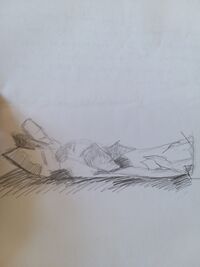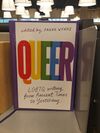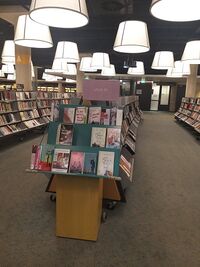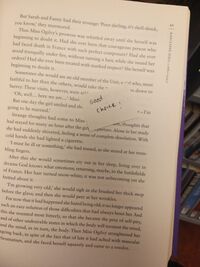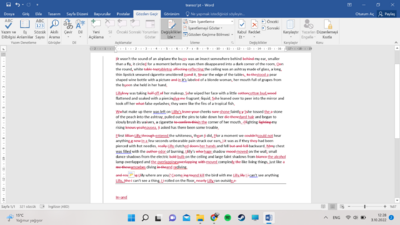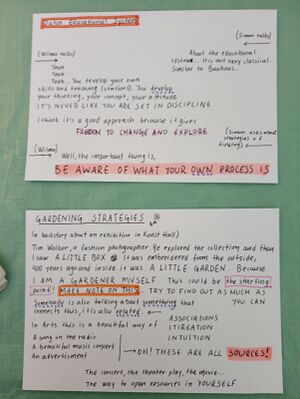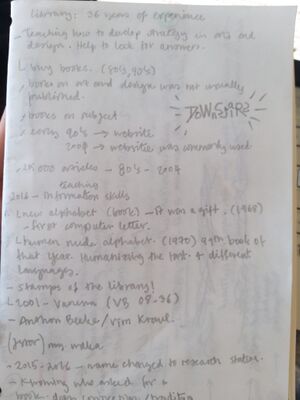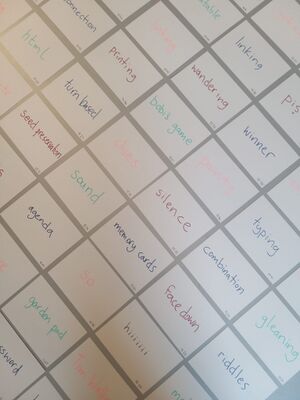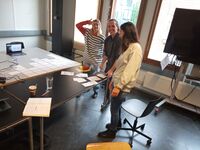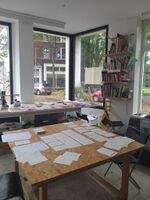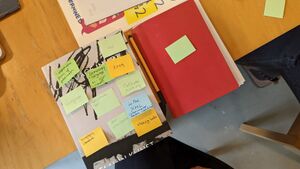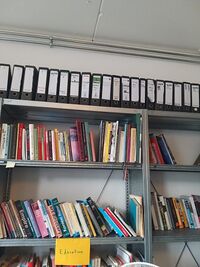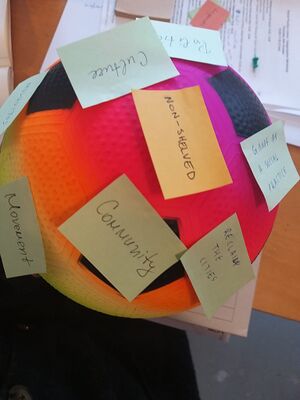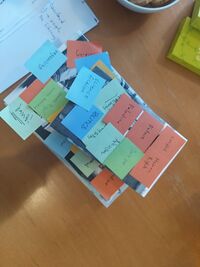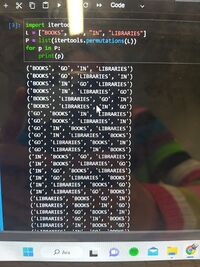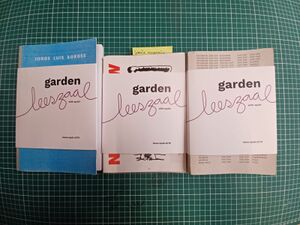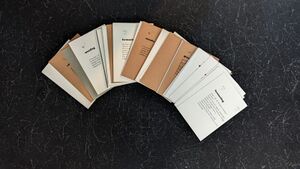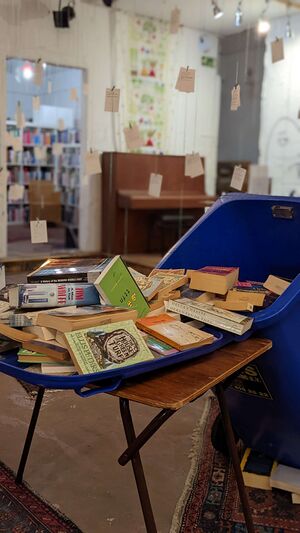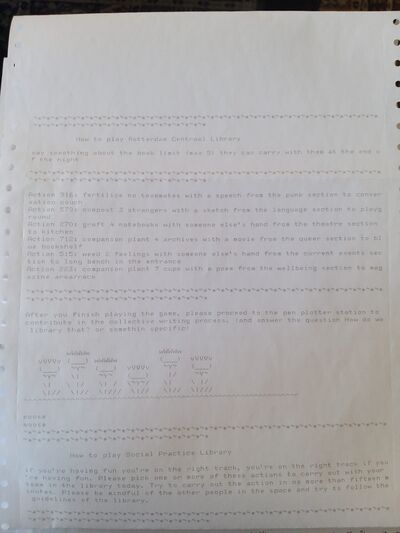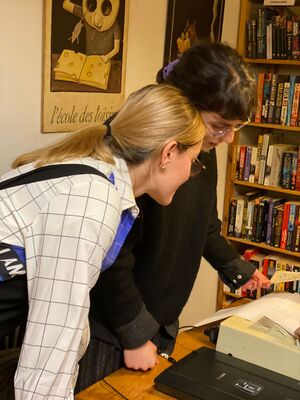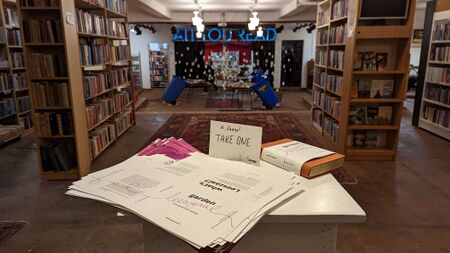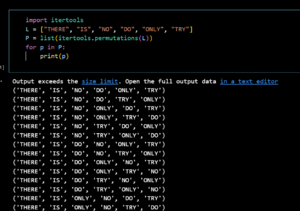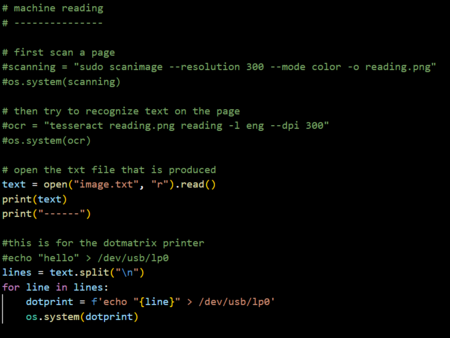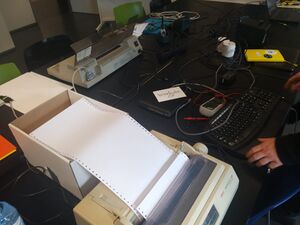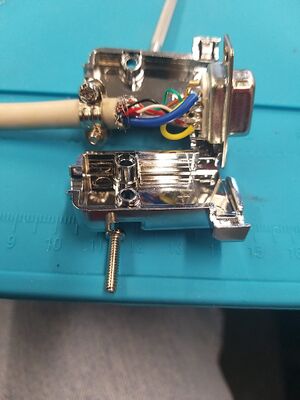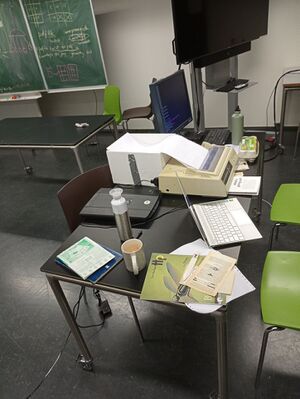Specıal ıssue 19
XPUB1 2022-2023
Eleanor's Workshop
I think the best kick off for school was Nor's workshop. It was a confusing day, overloaded with `needs`. Need to figure out where the academy is; the need to find the lab; the need to communicate and the need to find a place of comfort I guess. So when we started talking about our needs and other peoples' needs outloud, they suddenly became real and them quickly unimportant as well.
It was a relief to seperate that days needs, putting them in order and taking action about it.
In the other hand, it was very interesting to be intimate and vulnerable with strangers (classmates, hi) who will then become friends (hi again :)). I guess it was a good icebreaker because knowing how to identify someones needs or feelings is such a privelage and intimate experience.
Seeing how everyone felt similiar when they are distressed made the feeling of stress itself very funny :) So what if we feel shaky and have a stomach ache: we're in this together and we're owning our shit.
On the personal side, it made me think about stoicism and the ways to talk to someone who finds fighting is their way of communicating. How to avoid being heartbroken + how to understand that some things cant be controlled. I found this similiar to my relationship with Turkey. I feel like its always a fight and struggle where I try to communicate my needs in my way but cant seem to reach anywhere. so when I tried to make a map of the other side's needs, it turned out so far away then mine :)
Another thing was the fact that I was working on being angry. Because at some point last year, I realised that I never raised my voice to anyone or was truly angry. This was because at the moment I felt angry, I justified the other persons needs and tied them to their action and was not angry anymore. They were raised that way, they had a bad day, they learned to communicate in that way etc. But what I realized in the workshop, different than what I have been working with myself was that what I thought was empathy is actually justification. There is no limit to empathy but just because you are empathizing with someone doesnt mean you have to accept their actions. I guess I can call that an enlightenment moment!
We also tried to do quick sketches of a piece of paper and compared to understand how different everyone sees and expresses. Here is mine, which I thought was interesting because I focused so much on the shadow.
The Library Tour of Rotterdam-LIBHOPPING
Libhopping was very useful to discover the libraries in Rotterdam and what systems they are using to shelf books. It was nice to see how different they were from each other and how it depended on the size of the library. Our first trip was to Rotterdam Library. We found the library confusing and hard to get around. I found it weird that the search computers were only in Dutch. I tried very hard to search for a book and ended up asking the desk.
We wandered around and tried to see the classifications the library made. This was a huge topic in class because classifying books with keywords is a very personal thing. One might say a book is political where someone could see it as not. This is why there are so many sad movies in the comedy genre...
The Chich Lit section caught us off guard. We didnt really understand the need to classify this. In the end of our tour, I tried checking out a book from the library to see how it goes. This took more than half an hour. You have to be registered to the library which I couldnt do on the library computer because I dont know Dutch that well. When I asked the desk they told me it can be done online but I explained them how I didnt understand Dutch so we did it manually. This was a long process and the system was I think too complicated and formal. But I guess it is normal for a central library. So this was it, I now had a card and a book on libraries.
Our second trip was to Leeszal. This was a totally different atmosphere based mostly on trust and respect. The community library was warm and welcoming. There was no formality at all in the library system. They had a category system which we were to discover later on...
Special Issue 19-How Do We Library That?
Sesh#1
pad:https://pad.xpub.nl/p/SP19_22-09-19 NOTES ON TAKING NOTES -pen/pencil/paper -making lists and then getting back to it with arrows when I have to add something in between (which usually is the case) -evernote -never post-its: they get lost in outer space and you are left naked, not remembering what you had to do. -send messages to friends and text 'ignore' afterwards. isnt very sustainable in terms of keeping the friendship :) -on the back of receits. and when I lose them, which I do, trying to visually remember what I wrote. -on my arms or depending on the weather on my legs too. but then what should 'call' remind me? call who? back to the start... -videonotes
there was this time when we were so fed up with texting and found it very superficial so we started mailing each other weekly with my friend. That turned out perfect. Methods of notetaking we discovered:
1) transcribing everything word for word 2) Glossating – making glossaries / taking out the 'big ideas' / interpreting / keywording / skim writing 3) Contextualizing – including an observation of the relationship & dynamics of the conversationalists
reading and writing: the perfect combination of reading your thoughts as you are writing it. the two actions often go together.
annotations: annotations could be stains if you know how to read them. seeing a tangerine stain on a book can mean that this person, complete stranger took their time on this page and maybe you can guess which parts they took notes of. Annotations are specific ways of taking notes or maybe they arent at all. But you never know. if you see someone rewrote the same word on the page, what could that mean? Collectively, these forms of annotation indicate the presence of readers, making them visible to each other. Annotation lives in close proximity to the text. When it is separated from the text, it becomes unfixed, losing its symbolic power to remind us that other readers have also been here.
publication and publishing: publishing is an ending process where publication is not. editing a text can be seen as rewriting or creating a different version. when people have notes on the published material and create something new with it, this means the publishing process is still active. Publication is a slower, continuing process which aims for publishing to be sustained, an open process.
Making something public, and making publics. Matthew Stadler, writer and co-founder of the federated publishing network Publication Studio, makes a distinction between publishing and publication. For Stadler, publication happens not only through sharing texts, but also “setting up the circumstance through which we can talk and debate them, together”. Publishing survives through publication, which is the necessary creation and maintenance of the space created for a public; to read, to share texts, to discuss and publish them. Publication continues after the event of publishing.
on writing with a pen or pencil and its effect on our brains and creative process: http://www.futurity.org/for-kids-pens-mightier-than-keyboard/#more-4909 https://www.forbes.com/sites/nancyolson/2016/05/15/three-ways-that-writing-with-a-pen-positively-affects-your-brain/?sh=6de7d28e5705
Sesh#2
https://pad.xpub.nl/p/SP19_22-09-26 cards in our bag :) https://pad.xpub.nl/p/cards_in_bags_20220922 Moyra Davey, Fifty Minutes The Fridge, Books (the first 8 minutes) https://www.ubu.com/film/davey_50.html
We worked on transcribing a video. some of us tried to watch the video simultaneously. Bobi actually didnt watch the video and just transcribed what she heard. It was an interesting experience.
Then we made recordings and used the vosk transcriber to have it in text.
This was great to see because it made the machine world seem so vulnerable and ready to make mistakes. Seeing how comprehension has so much to do with human touch made me think about library systems again. I guess this is when I begin to think about how to combine transcription with vosk. It was interesting because my work before xpub was all manual with editing and translating. So combining these two ways was very intersting.
From Aglaia:) about the contingent librarian cards we did to add to the stach. Bo, me and Aglaia worked on Braille and cencorship definition and inclusions.
sensorship / lybraille-e
or lyi(brar)ing down in the margin (degrees of representation- there is a diagram at the paper of Olson "Mapping beyond Dewey's Boundaries")
see also: digitizing/printing, being kind to the reader, republishing
see also: censorship, including/excluding
All reading is a form of touching, and the act creates a connection between the reader and the text. Some texts encourage reading from certain readers (such as those typeset in braille), while some attempt to be universally accessible (such as those using OCR-A and OCR-B fonts).
Apparently the title "The Medium is the Massage" was in fact a typo after being sent to the typesetter, but McLuhan liked it so much that it was kept. Massage and also Mass Age alongside the original Message and Mess Age suggest multiple ways of approaching the text.
Sesh#3
https://pad.xpub.nl/p/SP19_22-10-03
What we did was to find a book and a passage from the bootleg library and record ourselves reading the text and transcribe it however we liked. I used vosk to do this and then edited all the parts the transcriber got wrong. The link to the html page for the transcription: https://hub.xpub.nl/breadcube/~suzan/ I extracted various parts from the book Transparent Blue and created a different narrative apart from the book itself. So then I had a small sequence from the book.
I worked on the transcribed text on word and the main purpose was to retrack the original text. But I tried to do this from memory. I tried to remember the original text and edited accordingly. There were some words that were transcribed as some other word that is pronounced the same way. Its easy to decieve a transcriber using language! you can talk meaninglessly but make the vosk transcribe it as you like.
such as: a me bees = amoebes
This then made me think about different cultures and pronounciations. how using a language that is not your mother tongue effects transcription and how can we mock it? Because why not :)
It wasn't the sound of an airplane the buzz was an insect somewhere behind my ear=it woah sent da saund of en heirplein da baz woahs en eensect sumwheir beehind mai eer. [=₀==₀]
THE LIBRARY IS OPEN*Libraries of librarians...*Anyone can become a librarian through calibre. *When everybody is a librarian, the library is everywhere.
1.https://www.memoryoftheworld.org/blog/tag/library/ 2.http://critlib.org/
Reading: The Undercommons
'the concepts are ways to develop a mode of living together, a mode of being to-gether that cannot be shared as a model but as an instance.'
'If concepts are tools for living or toyboxes for playing, when you pick up a text that’s finished, unless you’ve got some special texts that I don’t know of, you don’t get a sense of the playing or the living usually. What you get a sense of is some finished product where the collectivity animating the work that pre-ceded it – which I would agree with you is the most important thing – somehow gets lost along the way.'
publishing/publication?
Sesh#4
pad:https://pad.xpub.nl/p/SP19_22-10-10 Cards on the table:
After our talk with Wilma we worked on deciphering her speech in groups.
Transcribing manually. Aglaia and I focused on what the transcriber couldnt recognize in the recording. These are pauses, mimics, emotional moments and changes in tone. W tried to capture these moments using different colored pen and types of higlighting.
Textual production!-interpretation-Thinking in boxes.
Aby Warburg's work similiar in a visual way to our cards with Aglaia. There are scenes and seperations.
biblio-graph: https://biblio-graph.org/public/Also similiar in a way to present the process.
We were at Varia to see our results with the Garden metaphor and cards. We leaned towards games, card games and boardgames. seeds as heritage; regenerative libraries as a community garden
seeds as a way to cultivate your homeland elsewhere
seeds are coming home...
seeds as generation... re-generation
ancesteral seeds
Sesh#5
https://pad.xpub.nl/p/SP19_22-10-17
This class was so much fun because this is where we accepted the fact that the garden Wilma was talking about really striked all of our minds.
GAMES!
memory games or card games
we all made definiton of each of these gardening terms, related to texts and editing.
- pruning
swatchinggrafting, splicing
- composting
- gleaning
- fermenting
- tilling
- fertilizing
- crop rotation
- fallow
- weeding
- companion planting
- broadcasting - throwing seeds, reach broadly, "one-to-many"
We used pandoc and weasyprint to generate cards with each of our definitons.
Sesh#6
pad:https://pad.xpub.nl/p/SP19_22-11-07 Visited the social practice library. I have some handwritten notes.
The Social practice library was very interesting. It was a library that was formed from the personal collection of an artist. The practice involved research on categorization and library systems. I found this experience very different because first of all I would not be comfortable with opening up my personal library for everyone. Secondly, the fact that there were other people in the team who were working on the categorization of the books was not something I could understand. The artist gave them the freeedom to categorize her books so there wouldnt be a bias. Because as we all know, we get emotionally attached with printed matter :)))
Sesh#7
https://pad.xpub.nl/p/SP19_22-11-14
Working towards a
* Collective conversation
*Collective writing tool
* Collective archive
* Adaptive system
Sesh#8
https://pad.xpub.nl/p/SP19_22-11-21
MATERIALIZING THE METAPHOR
Terry Pratchett's library: https://wiki.lspace.org/Library
Greeting tools: map, set of cards with the action and tool to do action
Bring a book you want to work with or grab a book from the bin
Tools for every gardening action, determined by us more specific and clear. Generated in cards. More intimate experience and we will transparently show our understanding of the terms.
Stations to use: scanner, cutting, printing, pen plotter, copying, transferring.
why deconstruct a book?
participants can contribute to the definitons at the end by the pen plotter. ever going game... publishing versus publication.
why use the bin books: upcycling! using the books in the bin and create a new bookshelf
create something new with the "unwanted" books.
collective poem to define leeszal (bobi):https://universalpoem.com/
toolshed = stations
GAME PLAN (common elements between our prototypes):
1. Walk in, get MAP with instructions and also have a verbal instruction at the beginning.
2. head to the compost where you get a ceiling card with further instructions. Back on the card has a definition of the action.
3. Get the rules generated.
4. Pick a book
5. go to the station and pick the tool of the persons name. (definitons owner)
6. after finishing with the action head to the "collector? (reflect about what happend?)
7. input words of your liking in the lists displayed on the screen
8. next, proceed to the next action (new card?) - the goal is to go through all 6?, this is where the game ends
9. chill and relax
"Publications are empty pages if there is no one to read them.
Libraries are soulless storage rooms if there is no one to visit them.
People give meaning to libraries and publications alike. People are the reason for their existence."
Sesh#9
https://pad.xpub.nl/p/SP19_22-11-28
Examples of language-neutral operations...
Use whiteout to erase the punctuation
Pruning as an act of editing and creating a new text from an almost forgotten/ending book. Using dot matrix printer and image to text scanner to play with the whiteout-gaps applied by the readers. They can replace whatever text they want or adjust the text by adding/deleting punctuation.
This is an approach to play with both censorship and language. Pruning a text to make way for it to be better or grow.
Sesh#10and11
https://pad.xpub.nl/p/SP19_22-12-05
checking in
suzan: I'm good
SO LONG AND THANKS FOR ALL THE FISH!
Prototyping
Sesh#1
pad:https://pad.xpub.nl/p/SI19-prototyping-1
The birth of breadcube and me as a new person.
Sesh#2
login: root pas: m////g
https://pad.xpub.nl/p/SI19-prototyping-2
breadcube is back! and its crunchier than ever 🍞…ᘛ⁐̤ᕐᐷ
hub is a name that refers to a setup hidden network on the internet xvm: xpub virtual machine- wiki and stuff xvm is the only publicly reachable network. for example only xvm has a publicly reachable ip address
when connected to breadcube with ethernet or wifi, internet thinks xvm is one server but there are hidden network underneath such as bootleg of soupboat.
https://pzwiki.wdka.nl/mediadesign/HUB
install tinc to breadcube tinc is creating hidden networks.
https://hub.xpub.nl/breadcube/
ssh: secure shell- program to connect remotely to a server
'you can add your computer to the tink network and connect to breadcube with ssh.'
command line basics https://pzwiki.wdka.nl/mediadesign/Shell_Cheat_Sheet#Syntax https://pzwiki.wdka.nl/mediadesign/Shell_Cheat_Sheet#man_pages https://pzwiki.wdka.nl/mediadesign/Shell_Cheat_Sheet#meta_characters https://pzwiki.wdka.nl/mediadesign/Shell_Cheat_Sheet#File_Commands https://pzwiki.wdka.nl/mediadesign/Shell_Cheat_Sheet#pipe https://pzwiki.wdka.nl/mediadesign/Shell_Cheat_Sheet#write https://pzwiki.wdka.nl/mediadesign/Shell_Cheat_Sheet#append
grammar: $ (shows that this is a BASH command) command -options arguments
-the command is the name of the program to use -the options are the specific settings for the command -the argument is what you use the command on
- -root
$-user
~=home
..=going one folder back
sshortest way home: cd
"ip addr" for seeing the new ip
145.24.139.53
pwd= where am i now? root:/ cd: change directory + meta character takes you to a specific folder !! ls: list
/$= / you are at root
finding yourself and losing yourself again:
suzan@breadcube:/$ cd var suzan@breadcube:/var$ ls suzan@breadcube:/var$ cd www suzan@breadcube:/var/www$ ls html suzan@breadcube:/var/www$ cd html suzan@breadcube:/var/www/html ls suzan@breadcube:/var/www/html$ cd .. suzan@breadcube:/var/www$ cd .. suzan@breadcube:/var$ cd .. suzan@breadcube:/$
use the manual mannn! = man (whatever) dont act like you understood everything ٩꒰´· ⌢•`꒱۶⁼³₌₃
PERMISSIONS! drwxr-xr-x
421 421 421
d rwx rwx rwx
user owner group other u G O
chmod to change permission EITHER WITH NUMBERS OR U G O.
SUDO is a permission group* sudo test
< Hellloooo Suziii >
------------------
\ ^__^
\ (@@)\_______
(__)\ )\/\
||----w |
|| ||
There we go!
(⋆‿⋆)LUNCH (⋆‿⋆)
https://hub.xpub.nl/breadcube/~suzan/transparentblue.html filezilla and visual studio code as an editor.
created files and imported there to edit in the editor. save and refresh.
html and slight css :))
Sesh#3
pad: https://pad.xpub.nl/p/SI19-prototyping-3
We began with changing passwords and login to jupyterlab.
-markdown is a markup language. shortcut way. notebook can convert markdown to html language. -you have to press shift and enter to apply in the notebook. -work offline on the editor and then you can upload it on jupyter. -shared/html is for us to share things with each other -index is the home page.
HYPERWORLD <!DOCTYPE html> special tag to say that the page is an html page.
- wrap all your content in an html tag.
- <a href="x.html">hello</a> easiest way to reference a page.
HTML AND CSS id (you can use it once in a page and also used to point to specific part in a page) and classes ul: unordered list
- is the id and . is the class in css language.
Sesh#4
pad: https://pad.xpub.nl/p/SI19-prototyping-4
Working on Flex. svg and acss animation web to print format
Flex was a little hard to understand. Allignment and float was a bit confusing to understand but the games helped a lot.
Sesh#5
pad:https://pad.xpub.nl/p/SI19-prototyping-5
Python!
Using Python to generate poems and variations of texts.
Super interesting and intimadating to see how an algorithm can write something. The ultimate meeting of a calculator and a dictionary :))
Sesh#6
The craftsmen-Richard Sennet
Git Hub and open source.
"The Cathedral and The Bazaar"
copyleft understanding. Eric S. Raymond
'How can quality of knowledge coexist with free and equal exchange in a community?'
Git was invented for concerns about quality.
New Git Repository
PERMUTATION:
Sesh#7
pad:https://pad.xpub.nl/p/SI19-prototyping-7
Python for Image Recognition and text processing - some use cases we could try out Prototyping 09 Machine reading & scanning Pad: Machine reading & scanning
Tutorial about Scanimage - Linux only. Search alternatives for Windows and macOS.
Using Tesseract to turn the page into text (scan) and then translate it if it is in a different language then English. NOTES
NOTES
OCR = Optical Character Recognition Linux - scanimage! - script
run the command scan the page run the OCR command Result: scans transformed into a plain text Tesseract
Tesseract 4 adds a new neural net (LSTM) based OCR engine which is focused on line recognition, but also still supports the legacy Tesseract OCR engine of Tesseract 3 which works by recognizing character patterns.
Natural Language Toolkit (NLTK)
Natural Language Processing with Python - Tokenize and tag some text Part-of-speech tag Taggers & Tokenisers Tokeniser NLTK Taggers Alphabetical list of part-of-speech tags used in the Penn Treebank Project Try outs
Scan a page in Dutch - it didn't work because it couldn't recognise the language. Happy accidents :) the machine really tries to read the text (incl. images) Use the bar scanner - nice and easy. it recognises it as if it was a keyboard. We can generate barcodes pretty easily. The Screenless Office Official page Code isbn number character meaning
Sesh#8-9
We wrote a python script to scan and convert the image to ext and then send it to the printer. The problem was with the recognition of language. Some of the quotation marks or puntuation was not recognized so we had to insert a language input to the code. Also there was a problem with recognizing the gaps in the text. We tried by deleting some word from the text with whiteout and we were expecting for the printer to print these gaps as "gaps" but instead it printed %&DSFS. Also the scanner was having a hard time to recognize the color of the paper. If the paper was too yellow, like the very old books, the scanner couldnt recognize it because the settings were made to recognize black and white. So we tried to play with the contrast level of the scan to get a better result. Which kind of worked but there were still inaccuracies.
GIT: https://git.xpub.nl/suzan/si19_cutting
Research methods
pad:https://pad.xpub.nl/p/LeGuinAcaciaSeeds
Bootleg Library: https://hub.xpub.nl/bootleglibrary/shelf/96
She Unnames Them
Thinking about naming books and reading Ursula LeGuin:
The act of defining something obscure with a name can make the object/person/whatever less threathening in a way, since you can slowly get to know "what" you are up against. Just like in libraries and in the sense of "how?" can we library that. Maybe a start point, true or false in your opinion, a start point to research.
Is name a definition?
why do we have the need to name things at the very beginning. Maybe it has a connection with collectivity and the use of language. We feel the need to "address" people with certain callings- due to communciation. We need a way to communicate or ignite the communicate with a person. Or when we think of the time where there was no verbal language yet, then maybe names could be such trophies depending on our actions (someone who hunts a deer could be physically addressed in sign language showing the action)
"as predators we have a predatory view of the world."
Does this also apply to libraries?
Further Readings:
How we Became Posthuman- Katherine N. Hayles
The Carrier Bag Theory of Fiction:
Thealways expected tragedy of the hero
Hero Library
What is the economy of knowledge? How knowledge was produced and distributed in the hero library?
you have to pay something in order to get access, earn it. you have to be able to afford it.
it's exclusive not inclusive
cannon - 1/ power - 2/ wealth - 3/ growth
hero's library would be monumental with columns.
silent
how do you make a library start and end
limited access (physical or non-physical, stairs or paywall)What is the economy of knowledge? How is knowledge distributed and produced?
the same translates to non-phisical spaces but digital libraries too. subscription models and levels of access
special cards and special treatments and monumental large scale concrete/marble/stone buildings.. the few privileged ones get the most special knowledge the most valuable.. what is the most valuable knowledge? who are the privileged ones? how did they manage to acheive this? the top? UP/VERTICAL, surveillance and control, aesthetics of power (regarding the construction)---maybe the knowledge itself has to do with the consumption/we consume knowledge/information we do not create/produce
no non-silent rooms or group working areas
obedience
the knowledge is rather taken (acquired) from somewhere else
, many levels from bottom to the top. the higher you go the most important stuff you can access (the most valuable knowledge)
big history section on victories
censorship?
security
many mirrors inside
property/ ownership of knowledgement
Hero's library slogan:
hoc est quod vos adepto
echo chamber (Stephen)
-there may be many replicas of the same book. "the bible of the hero library" rewritten, how to read "the bible of the hero library", new edition, new cover etc.
there can only be one hero library (with notion to capitalism as Bo said)
Carrier Bag Library
| What is the economy of knowledge? How knowledge was produced and distributed in the Carrier Bag library?
free access, exchangeable, everyone has the same
you could request books depending on your research
what monuments could there be?maybe no static monuments.. maybe counter monuments-always vulnerable and transformative
flexible, open, adjustable, circular, limitless (can add and add and add and transform), without borders, liquid or smooth textured, horizontal, people make their own decisions/terms of classification/organization
A bag where people add as much as take away, where the mastery of knowledge is less important than the sharing of information, mutual knowledge
Leeszaal (no checkout, relationship built on trust and knowledge not seen as private propriety) Within a society of surplus, book donation makes sense
looks like a net (network), each part is connected to each other, through knots _ nodes (some small, some bigger)
infinite?
no checkout policy
mobile and it can change place
Who has ownership over the objects?
open to risks- but easy to reconstruct due to collectivity (knowledge is fluid)
living form/changing constantly- knowledge to find solutions
bags made of reeds
what happens if a carrier bag librarian walks into a hero library? what would give them away?
^^^this sounds like the start of a joke
what are the rules in a carrier bag library? who decides the rules, are they fixed?
An archive that is not static, is only useful if it's useful to users
"May be seen as necessary elements of a whole, which itself cannot be characterised either as conflict or as harmony since its purpose is neither resolution nor stasis but continuing process" - LeGuin on carrier bags
There can be more than one carrier library in contrast to capitalism.
Cards of our Own-WHAT, HOW, WHY
Aglaia and my approach on Wilma's transcription:
Project description
(log line-
what
2 handwritten transcriptions of the same text. An extract of an interview with Wilma, librarian at WdK and HR for the last 36 years. The two handwritten transcriptions serve as a conversation between the two notetakers. The similarities and differences between the two texts. (At time of talking these notes). Ingedients include: pen, pencil, paper, ears, hands. The conversation can be extended to more cards.
how:- (At time of talking these notes [2pm]) The [5] cards serve as an interface to other texts (through hyperlinks and references)
why: Both Aglaia and Suzan were interested in conveying the space and atmosphere of the conversation. They want to convey the experience of the conversation (and not just the information it transmits).
Seeing this video helped me understand the idea better: A talk with Donna Harraway https://www.youtube.com/watch?v=59bLqzrM2r0
Generated Cards/relevant content
pad:https://pad.xpub.nl/p/Methods19Oct22 We worked on how to generate relevant cards to the special issue. We had many ideas but not one that we were all content with. Talked about Utopias and imaginary places which made me go back to The Dictionary of Imaginary Places Book by Alberto Manguel and Gianni Guadalupi.
wrote our definitions on some terms: Fermenting: All fresh fruits and vegetables are natural hosts to all kinds of microorganisms such as <a href="growing.html">bacteria</a>, yeasts, and molds. Through fermentation, we encourage the beneficial bacteria to participate in the process of preserving our vegetables. Growing: Some things are left incomplete. That's also another way of being complete. Weeding: The act of removing different bits of a whole to make a space look better and give more freedom to chosen parts to flourish. Also known as discrimination based on aesthetics and human domination on nature
Game on
pad:https://pad.xpub.nl/p/SI19-20221102 Using our cards and definitions to explore and organize the XML Library. This ended up in color coding the library and seperating (pruning) the duplicates. I think at this point we realized that these cards arent for playing or organizing. So this was somewhat like a turning point for me. Also this was the point where we realized that we alone cannot answer the question of "how do we library that?" this would be such a hero way of approaching to this issue.
What is a game anyway?
Everyone has a personal way of “librarying” something, with a different intention; either discovering or searching, socializing, working on something. When we think about the open endedness of this question, it is possible to approach it as an infinite one. We can say that an experience in any library is an ongoing one and can be researched or publicated through a metaphorical gardening game. We are inviting every librarian (librarians of their own library) to take part in discovering how they approach library systems and the space itself collectively. We will try to create a collective writing piece, an instant print at the release time, to try and create a piece of writing with many authors. This of course gives opportunity to change and evolve in time, with direct relation to how many new people are a part of this discovery each time.
Guide Steve through the game.
suzan: -visitors will come in and will have time to discover Leeszal and its library practices, guided by us? -They will be asked to write a short reflection about how they organize their library, and what they look for in a library. -Participants will be set in groups and will be asked to pick four cards from the deck -The ptyhon rules will generate for each group. -The group will write their own definitions for the cards they picked, in relation to leeszal? -everyone wil come together and we will try to combine these definitions in a plain text? Or add them to cards? -Everyone will leave with a deck of cards or a piece of collective text?
In what other ways does HDWLT work (other than a "workshop")? I have been looking for a book that I lended to a friend years ago. I dont remember the title. I have been to libraries and bookshops, I searched for it online but I still can’t find it. HDWLT could also be a search engine for people who look for specific kinds of books online or in real life. Or it can be about what is in a book’s tag, what is an ISBN, who works to create a book… For me, these are the most direct ways to approach this question. How can we attribute words to define books? How can we search for ambigious or abstract things in any library?
Defining the "issue" A momentary snapshot of the current state of Leeszaal library seen as a garden of knowledge and people who experience it in that very moment. HDWLT is an exploration of networks of humans and texts, their context and modes of operation. What are we offering: "We are inviting every librarian (librarians of their own library) to take part in discovering how they approach library systems and the space itself collectively"
I went to the Frankfurt Book Fair and saw a pen plotter there which was typing in real time an infinite poem. This really caught my attention and I thought we could really use this in our collective approach. Using a space limited print that everyone present can contribute to. I loved the idea! Also Leeszal seemed to be the best atmosphere to do this. link:https://www.dailymotion.com/video/x8erni3
What is a game? A game for me is a feeling that I carried from my childhood. It is excitement, a sense of unharmful danger and an escape. Even if its a marble game, hide and seek or frezee, it always is an intimate way to learn about people, talk to people and understand behaviors. I always seek for a motivation in a game, other than the motivations listed above. A need to say “I did it!” or sometimes “I failed…” Have more or less of the cards, marbles etc. I had in my hand at the beginning. So its fair to say that at the end of a game I would expect a visible change. A comfortable agreement (even if I "lost" the game) and a sense of belonging.
What is play and what is game? They are different things.
Favorite games: My favorite game is Hide and Seek because I love the excitement it brings, I have good memories with it and still believe it is a good way to understand how people think. I remember it always surprised me to find people in the most unexpected places and I would be -and still- a little bit amazed of how differently we think.
After everyone's answer, the keyword was amazement.
What is a workshop?: A workshop is a type of work you can shop. It’s an event where you contribute (money, materials…) and in return, you learn how to work on something. You have an end result and can take it (material or thoughts) with you. But mainly it is something new for you or something you improved at that very time. My favorite workshop was metal workshop because we wore masks and joined stuff with flames.
The Day
https://pad.xpub.nl/p/SI19(Steve)2309 Planning our workflow and to-do listssss.
Readings
-Raspberry Pi- How to Get Started -The Craftsmen -Exploratory Programming for the Arts and Humanities -Hyperworld -Mapping Beyond Boundaries -Carrier Bag Theory of Fiction -Acacia Seeds -An Analysis of Plato's Political Thought -The House of Dust -The Card Catalogue -A Pattern Language -The Zettelkasten of Nicholas Luhmann -An Anarchist Introduction to Federated Social Media -The Atlas of New Librarianship -As We May Think
Pagedjs Workshop
pad:https://pad.xpub.nl/p/pagedjs
Single source publishing: we publishing- not an object but a content. making one content available in all possible sources.
flux pagination: page numbers, header, footer, page float is not available in a default web print.
booksprint= https://www.booksprints.net/: makes a pdf ready to print in 5 days.
THREE IMPORTANT POINTS FOR PAGEDJS:
-based on w3c web standards html-css-pagedjs
-DevTools
-Pollyfill code that implements features on web browsers that do not support the features. Polyfill the Greek word for hack! :) pagedjs transforms the css code for all web browsers to support. pagedjs makes the code "understandable" for the browser.
walden pond zine: https://waldenpond.press/
coko: https://coko.foundation/ supports open source publishing.
preview for pagedjs: https://www.lesvoisinsdustudio.ch/hybrid/hybrid.html
starter kit for pagedjs: https://gitlab.coko.foundation/pagedjs/starter-kits/print-a-webpage

